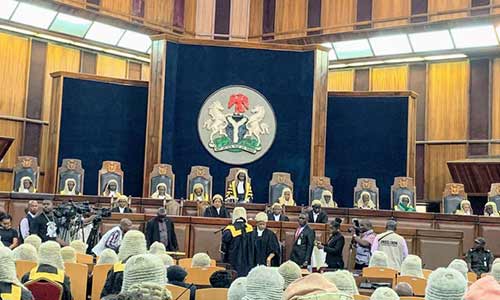SUPREME COURT JUDGEMENTS 03/01/2023
When Circumstantial Evidence Can Ground A Conviction For Murder

In the Supreme Court of Nigeria
Holden at Abuja
On Friday, the 17th day of June, 2022
Before Their Lordships
Olukayode Ariwoola (now CJN)
Uwani Musa Abba Aji
Mohammed Lawal Garba
Adamu Jauro
Emmanuel Akomaye Agim
Justices, Supreme Court
SC/466/2014
Between
OGEGE EGBERTAMU APPELLANT And
THE STATE RESPONDENT
(Lead Judgement delivered by Honourable Olukayode Ariwoola, JSC (now CJN)
Facts
The Appellant was arraigned before the High Court of Delta State for the murder of one Oghenekome Obogho on 10th November 2003, punishable under Section 319(1) of the Criminal Code, Cap. 48, Vol. II, Laws of Bendel State 1976 as applicable in Delta State. The case of the Prosecution was that the Appellant and the deceased were lovers, and the Appellant was in the habit of beating the deceased on the allegation of infidelity, which caused a strain in their relationship, and the Appellant eventually murdered the deceased. The Respondent called five witnesses in proof of the Charge. The Respondent’s key witness – PW1 – Enakome Evvie, a female friend of the deceased, testified that the deceased moved to her house at Oleh in Delta State sometime in November 2003, and the Appellant had on different occasions visited the house and threatened the deceased, and had even on one occasion hit both the deceased and PW1 with a motorbike. PW1 testified further that on 10th November, 2003, the Appellant again visited the deceased at PW1’s residence, discussed with her and left.
At about 10pm on the same day, the deceased went outside to empty her bowels when PW1 heard the deceased scream her name from outside that “Enakome come to rescue me, Ogege (the Appellant) is killing me”. PW1 testified that on rushing outside, she found the deceased in the pool of her own blood with deep cuts on her head and beside her ear, and she heard the sound of a motorcycle zooming off through the bush as she shouted for help. Ultimately, the case of the Respondent was that the Appellant killed the deceased based on the circumstances of the several previous threats issued by the Appellant against the deceased, and the Appellant’s presence at the scene of the crime on 10th November, 2022 prior to when the crime was committed, and based on the dying declaration of the deceased. At the conclusion of trial, the court found the Appellant guilty of murder from the circumstantial evidence adduced before it, and sentenced him to death by hanging.
Dissatisfied, the Appellant appealed to the Court of Appeal, which court upheld the findings of the trial court that the Prosecution had proved its case beyond reasonable doubt. The Court of Appeal, thereby, affirmed the conviction and sentence of the Appellant. Further dissatisfied, the Appellant filed an appeal to the Supreme Court.
Issue for Determination
The Apex Court considered the following sole issue for its determination of the appeal:
Whether from the circumstantial evidence adduced by the Prosecution, the Court of Appeal was right in affirming the decision of the trial court that the Respondent proved the charge of murder against the Appellant beyond reasonable doubt.
Arguments
Counsel for the Appellant submitted that the circumstantial evidence adduced in the case, fell short of the standard and quality required to prove the charge of murder against the Appellant. He argued that before the Prosecution can rely on circumstantial evidence to ground conviction in a criminal trial, such evidence must be cogent, complete and unequivocal. Relying on OGIDI v THE STATE (2005) NWLR (Pt. 918) 286 at 319, counsel for the Appellant argued that the circumstantial evidence to be used by the Prosecution must be incompatible with the innocence of the accused, and incapable of explanation upon any other reasonable hypothesis than that of his guilt. He submitted that there are general co-existing circumstances that greatly weakened, diluted and completely destroyed whatever circumstantial evidence that was adduced by the Prosecution. He argued that instances of previous quarrels and visit of the Appellant to the deceased prior to the attack, cannot be used to hold the Appellant responsible for killing the deceased, in the absence of any other credible evidence linking the Appellant with the attack on the deceased. He contended further that none of the prosecution witnesses gave evidence that they saw the Appellant attacking the deceased, or that the Appellant was seen within the scene of the crime immediately after the attack.
On the dying declaration of the deceased, counsel for the Appellant contended that the trial court was wrong in relying on the dying declaration which did not identify the Appellant as the person who killed the deceased. He argued that the testimony of PW1 on the alleged dying declaration was not a circumstantial evidence that the court can safely rely on, to conclude that the Appellant was the person referred to as the accused in the deceased’s dying declaration. He urged the court to hold that the evidence of PW1 lack precision, clarity, consistency and therefore, unreliable for the purpose of holding the Appellant responsible for the death of the deceased.
Responding to the arguments of the Appellant, counsel for the Respondent submitted that the totality of the evidence before the court were cogent, compelling, unequivocal as to the guilt of the Appellant. He referred to the various testimonies of the prosecution witnesses, particularly the testimonies of PW1 – a friend of the deceased; PW2 – the uncle of the deceased who identified the corpse of the deceased; PW3 – the father of the deceased; PW4 – Medical Doctor who performed autopsy on the deceased and; PW5 – the Investigating Police Officer who investigated the case. He contended that their testimonies constituted overwhelming evidence that proved the ingredients of the offence of murder against the Appellant that the deceased died, that the Appellant killed the deceased and that the act of the Appellant in hitting the deceased with a sharp object on the head and causing a deep cut running from the front of her right ear to the back of her head was intentional with the knowledge that death or grievous bodily harm was its probable cause. He submitted that the pieces of evidence even without more positively linked the murder of the deceased to the Appellant. He urged the court to dismiss the appeal and affirm the conviction and sentence of the Appellant.
Court’s Judgement and Rationale
In deciding the appeal, the Supreme Court described the offence of murder as taking of human life by a person who either (a) has a malicious and wilful intent to kill or do grievous bodily harm, or (b) is wickedly reckless as to the consequences of his act upon his victim. For murder, there must be an evil intent, that is a criminal intent, although it is not necessary that there should be an intent to kill. Further, by the Criminal Code, an offence of murder is committed when a person unlawfully kills another under any of the following circumstances: (i) if the offender intends to cause the death of the person killed, or that of some other persons; (ii) if the offender intends to do to the person killed, or to some other person some grievous harm; (iii) if death is caused by means of an act done in the prosecution of an unlawful purpose, which act is of such a nature as to be likely to endanger human life; (iv) if the offender intends to do grievous harm to some person for the purpose of facilitating the commission of an offence which is such that the offender may be arrested without warrant, or for the purpose of facilitating the flight of an offender who has committed or attempted to commit such an offence; (v) if death is caused by administering any stupefying or overpowering things for either of the purposes last aforesaid; (vi) if death is caused by wilfully stopping the breath of any person for either of such purposes. In the second case, it is immaterial that the offender did not intend to hurt the particular person who is killed; in the third instance, it is immaterial that the offender did not intend to hurt any person; and in the last three cases, it is immaterial that the offender did not intend to cause death or did not know that death was likely to result – SABINA CHIKAODI MADU v THE STATE (2012) 15 NWLR (Pt. 1324) 405.
The Apex Court reiterated the firmly settled law that for the Prosecution to succeed in a charge of murder under Section 319(1) of the Criminal Code, it must prove beyond reasonable doubt that: (a) there was a killing; (b) the killing was unlawful as prohibited by Section 316 of the Criminal Code; (c) it was the act or omission of the accused person that caused the death of the deceased; (d) the accused intended to cause the death of the deceased. The court referred to GRACE AKINFE v THE STATE (1988) 3 NWLR (Pt. 89) 729 at 745; AKPAN v THE STATE (1994) 9 NWLR (Pt. 368) 347.
The court held that in criminal trials, the guilt of an accused can be established by either the confessional statement of the accused, or by circumstantial evidence, or by the evidence of an eye witness. A court could properly infer from cogent circumstantial evidence, that the death of the deceased was caused by the act of the accused person even without any other evidence, once it irresistibly and compellingly leads to the reasonable conclusion of the guilt of the accused person and no other person. ESAI v THE STATE (1976) 11 SC 39; ISMAIL v THE STATE (2008) 15 NWLR (Pt. 1111) 593.
Their Lordships held that the trial court rightly found that the ingredients of the offence of murder were proved by the Prosecution, based on the testimonies of the prosecution witnesses. Furthermore, to know whether or not it was the act of the Appellant that led to the death of the deceased, the trial court analysed the circumstantial evidence before it, together with the statement of the Appellant – Exhibit A wherein he stated that he was very angry that the deceased left him to live with another boy, and he had threatened the life of the deceased and the said boy at different times, and the trial court came up with the following conclusion that: (a) the assertion that the relationship between the deceased and the accused was strained was not in doubt; (b) the accused was bitter (c) the accused threatened the deceased was not in doubt; and (d) the Appellant was in Oleh in November 2003 was not in doubt. Thus, the defence of alibi pleaded by the Appellant was unsubstantiated, and the trial court rightly rejected same.
Further, the Supreme Court decided that in this appeal, the circumstances of the death of the deceased former girlfriend of the Appellant, which is substantially contained in the evidence of PW1 and the Appellant’s own statement to the Police admitted as Exhibit A at the trial, unequivocally, directly and unmistakably pointed to the acts of the Appellant, as to totally exclude any reasonable hypothesis than his guilt. The Court of Appeal could therefore, not be faulted in its conclusion that the trial court rightly held that the Prosecution proved the case beyond reasonable doubt, upon the overwhelming circumstantial evidence against the Appellant.
Appeal Dismissed.
Representation
A. Olungwe Kabibo, Esq. for the Appellant.
Olivia Agbajo Esq. for the Respondent.


